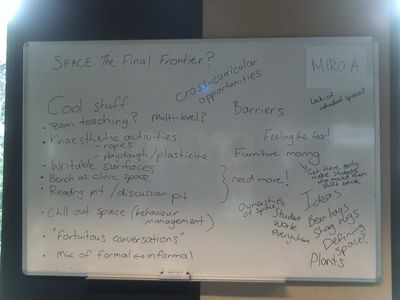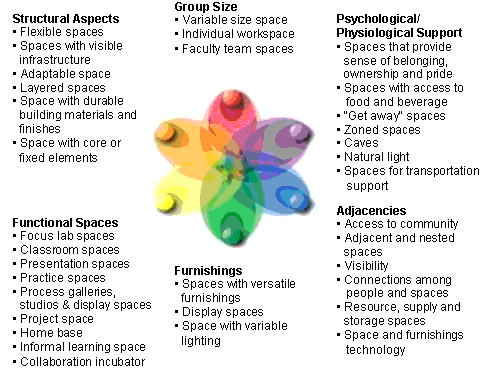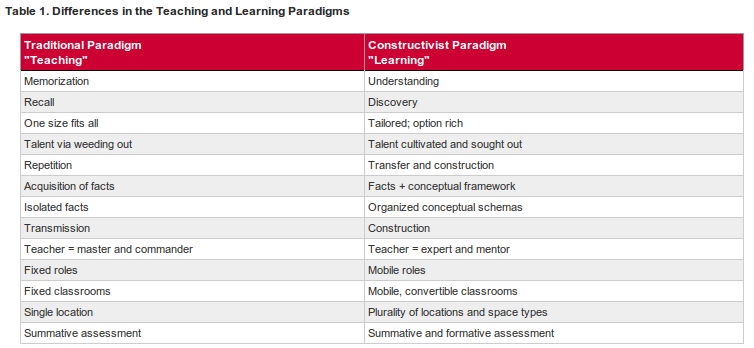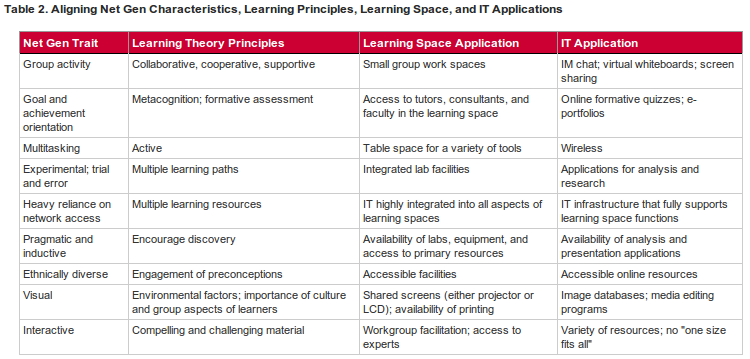Learning spaces
From WikiEducator
How can we make better use of our learning spaces?
Contents
What are flexible learning spaces?
- Examples of Learning Commons
How can we best make use of them?
Informal learning
- Use the kitchenettes as 'clinic space'. Rotate students through the seats by the kitchenette where they have to i) demonstrate they know
- Conversation pits
- Soft furnishings
- Mats, cushions, beanbags
- Can we arrange the furniture so that the formal learning furniture is near the windows and the informal furniture is near the centre of the building?
- Can we be making better use of the traffic areas for informal learning?
Walls and pinboard
- How do we promote better showcasing of learning on the walls of the learning spaces? Is it a problem of shared ownership?
- Use the windows to draw things on.
Readings/research
- Prakesh Nair http://www.designshare.com/images/LearningLandscapeNairGehling.pdf
- Kenn Fisher http://www.eduweb.vic.gov.au/edulibrary/public/assetman/bf/Linking_Pedagogy_and_Space.pdf
- Victoria Department of Education (Australia): Building the Education Revolution project, particularly "Making the most of flexible learning spaces - a guide for principals and teachers" (PDF - 13 Mb)
- TLT (Teaching, Learning and Technology) Group: Teaching/Learning Activities, and Learning Spaces that are Good for Each of Them (it doesn't look like much, but click through to each of the underlined sections for more info).
- Innovative Learning Environments: The American Institute of Architects Committee on Architecture for Education Conference, Amsterdam 2000. In particular a Q&A session with architect Bruce Jilk, Parts Three ("Learning environments (spaces designed with learning as the primary goal) will be multifunctional. They need to support formal learning, informal learning, and resource learning. I call these the learning threads. The learning environment is a fabric made up of these threads. Creating single-purpose spaces (math classroom, circulation corridor) is a barrier architecture, not an enabling architecture.") and Four ("Instead of designing schools we should step back and design community").
- JISC UK's section on Designing Spaces for Effective Learning has many articles, multimedia resources, downloadable case study videos etc - when you have some time that's worth delving into as well!
- Howard Strauss, New Learning Spaces: Smart Learners, Not Smart Classrooms
- Susan Wolff http://www.designshare.com/Research/Wolff/Project_Learning.htm
EDUCAUSE have lots of material on learning spaces:
- The 2006 e-book "Learning Spaces" (ed: Diana Oblinger) is well worth a look, particularly chapters 3 ("Seriously Cool Places: The Future of Learning-Centered Built Environments") and 12 ("Sustaining and Supporting Learning Spaces").
- Volume 32, Number 1 of the EDUCAUSE Quarterly Magazine in 2009 was a special issue on learning spaces - 14 decent articles and a great photo feature.
- Malcolm Brown's chapter "Learning Spaces" in the e-book "Educating the Net Generation" is enlightening, in particular Tables 1 and 2 (reproduced below).








